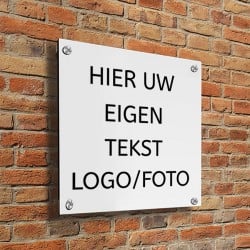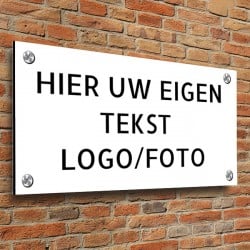Creating a Stunning Text Board for Any Occasion

Text on board shows is just a critical factor in interaction across airports, community transportation techniques, educational institutions, and actually public advertising. The potency of these messages depends very on what make sign with your own text (bord maken met eigen tekst) is displayed. The process is based on advertising necessary data easily and clearly to diverse readers without overwhelming or puzzling them. Below are the most effective practices to assist you convert your text-based displays in to efficient tools of communication.

1. Hold It Concise
When creating text for just about any board exhibit, brevity is your very best friend. Research shows that the typical person's attention span is just 8 seconds—essentially shorter than that of a goldfish. Contemplating this, it's crucial to prioritize information.
•Stay to at least one main message per screen.
•Use three- to five-word headers that review the content.
•Supplement with round details when record details.
As an example, in place of “Next Boarding for Journey 8976 Is Occurring at Door 12,” simplify it to “Trip 8976 Today Boarding - Door 12.”
2. Pick Readable Fonts
Typography may possibly produce or separate your communications. A display that's hard to see will anger people and beat the purpose of predicting the information. Give attention to these core principles to boost readability:
•Use sans-serif fonts (e.g., Arial, Helvetica) because they are simpler to read from the distance.
•Prevent decorative or software fonts, which might search trendy but absence clarity.
•Maintain the absolute minimum font measurement of 24 details for far-distance visibility in small spots and change upwards for larger areas like arenas.
Studies demonstrate that users are 20% prone to keep data from text published in clean, understandable fonts in comparison to chaotic typography.
3. Contrast is Master
Legibility depends significantly on the comparison between text and its background. High comparison guarantees that visitors of all age ranges and observing conditions—including those with visible impairments—can certainly realize your message.
•Go for light-colored text (e.g., white or yellow) on black backgrounds (e.g., black or navy), or vice versa.
•Avoid very active skills like images or styles behind the text.
•Test your displays in situations with varying mild conditions.
A board with effectively balanced comparison has been revealed to enhance comprehension charges by 45% among users.
4. Use Visible Hierarchy
Order and framework are essential for guiding the viewer's eye throughout your message. By employing visual hierarchy, you'll help audiences absorb important data quickly.
•Design your text in levels, emphasizing headlines in larger, strong fonts and supporting facts in smaller type.

•Use shade development and bolding to indicate desperation (e.g., red for alerts like “Warning – Elusive Floors”).
5. Check Before You Release
It's critical to check your text's performance in a real-world setting. Gather feedback from a varied group of people to spot possible challenges with visibility, appreciation, and monitor placement. Implement their records into your design period for streamlined ultimate displays.
When executed properly, text on board shows can elevate the efficiency of your communication strategy. By prioritizing simplicity, legibility, aesthetic hierarchy, and market screening, you can cause impactful visible shows that truly resonate along with your audience.
